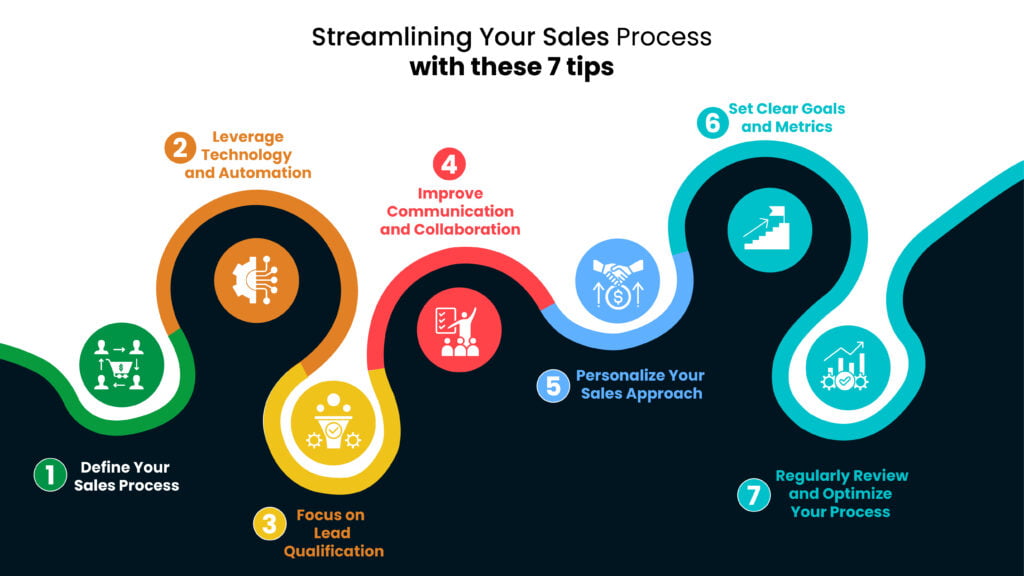Improve Your Sales Process for Better Conversions

Having a smooth sales process is very important for any business. When your sales process is organized, your team can work more efficiently. This means they can spend less time on tasks and focus more on helping customers and closing deals.
Streamlining your sales process can lead to better productivity and more sales. In this blog, we will share seven simple tips to help you make your sales process easier and more effective. Let’s get started and see how you can improve your sales strategy!
Tip 1: Define Your Sales Process Clearly
The first step to streamlining your sales process is to define it clearly. Many businesses make the mistake of having a vague or inconsistent process, which leads to confusion and inefficiency. A well-defined sales process outlines every step a prospect takes from the first contact to closing the deal.
How to Do It:
- Map out each stage of your sales process (e.g., prospecting, qualification, demo, proposal, closing).
- Document the actions required at each stage (e.g., sending an email, or scheduling a call).
- Share this process with your team to ensure everyone is on the same page.
Why It Works: A clear sales process eliminates guesswork, ensures consistency, and helps your team stay organized.
Tip 2: Leverage Technology and Automation
Using technology and automation can greatly simplify your sales process. There are many tools and software available that can help automate repetitive tasks, saving your team time and effort. Here are some key benefits:
- Automating Repetitive Tasks: Tools can handle routine activities like sending emails, scheduling meetings, and updating records. This allows your team to focus on more important tasks, like building relationships with customers.
- Using CRM Systems: A CRM system helps you manage leads and sales more effectively. It keeps all your customer information in one place, making it easy to track interactions, monitor sales progress, and manage follow-ups.
- Lead Tracking and Follow-Ups: Automation can help you track leads automatically. For example, you can set up reminders for follow-ups or send automated emails to nurture leads without manual effort.
SalesTown Sales CRM is a great example of how technology can help streamline your sales process. It allows you to manage leads efficiently, automate follow-ups, and keep track of all customer interactions in one system. This means your sales team can spend less time on admin tasks and more time selling, leading to better results!
Tip 3: Focus on Lead Qualification
Not all leads are created equal. Spending time on unqualified leads can drain your resources and slow down your sales process. Lead qualification helps you identify the prospects who are most likely to convert, so you can focus your efforts where they matter most.
How to Do It:
- Use a framework like BANT (Budget, Authority, Need, Timeline) to assess leads.
- Ask qualifying questions during initial conversations.
- Score leads based on their likelihood to buy.
Why It Works: By focusing on high-quality leads, you can prioritize your efforts and close deals more efficiently.
Tip 4: Improve Communication and Collaboration
Improving communication and collaboration within your sales team is essential for success. Here’s why it matters and how you can enhance it:
- Importance of Communication: Clear communication helps ensure that everyone on the team is on the same page. When team members share information, updates, and strategies, it reduces misunderstandings and fosters a unified approach to selling.
- Benefits of Regular Team Meetings: Holding regular meetings helps keep everyone informed about progress and challenges. These meetings provide an opportunity to:
- Share updates on leads and sales activities.
- Discuss any obstacles the team is facing.
- Brainstorm new ideas and strategies.
By improving communication and collaboration, your sales team can work more efficiently and effectively. When everyone feels connected and informed, they’re more likely to achieve their sales goals and provide better service to customers!
Tip 5: Personalize Your Sales Approach
Personalizing your sales approach is very important for connecting with customers. Here’s why it matters and how you can do it:
Importance of Personalization: When you tailor your sales pitch to meet the specific needs of each customer, they feel valued and understood. Personalization can lead to stronger relationships and higher chances of closing a sale.
Tips for Tailoring Your Pitch:
Know Your Audience: Research who your potential customers are. Understand their industry, challenges, and what they might need from your product.
Use Their Name: When communicating, use the customer’s name. This simple gesture makes the conversation feel more personal.
Customize Your Message: Instead of using a one-size-fits-all approach, adjust your pitch based on the customer’s needs. Highlight features of your product that are most relevant to them.
Examples of Effective Personalized Communication:
Follow-Up Emails: Instead of sending a generic follow-up, mention specific points from your last conversation. For example, “I hope you found the information on [specific topic] helpful.”
Tailored Offers: If a customer shows interest in a particular feature, offer them a special deal or more information related to that feature.
Birthday or Anniversary Messages: Sending a personalized message on special occasions can strengthen your relationship and show that you care.
Tip 6: Set Clear Goals and Metrics
Setting clear goals and metrics is crucial for a successful sales process. Here’s why it matters and how you can implement it:
- Importance of Measurable Goals: Having specific, measurable goals gives your sales team a clear direction. When everyone knows what they need to achieve, it helps them stay focused and motivated. Measurable goals also allow you to track progress and identify areas for improvement.
- Examples of Key Performance Indicators (KPIs) to Track:
- Sales Revenue: The total amount of money generated from sales over a specific period.
- Number of Leads: The total number of potential customers you have contacted or engaged with.
- Conversion Rate: The percentage of leads that turn into actual sales. This helps you understand how effective your sales efforts are.
- Average Deal Size: The average amount of money earned from each sale, which can indicate the value of your products or services.
- Adjusting Strategies Based on Performance Data: Regularly reviewing your KPIs helps you see what’s working and what isn’t. If you notice that your conversion rate is low, you might want to adjust your sales tactics or focus more on lead qualification. By analyzing performance data, you can make informed decisions to improve your strategies and achieve your goals.
Tip 7: Regularly Review and Optimize Your Process
Regularly reviewing and optimizing your sales process is essential for staying competitive and effective. Here’s why this is important and how you can do it:
Importance of Continuous Improvement: The sales landscape is always changing, and what works today may not work tomorrow. By continuously improving your strategies, you can adapt to new trends, customer needs, and market conditions. This proactive approach helps ensure your sales team remains effective and successful.
Methods for Gathering Feedback and Analyzing Results:
Surveys and Questionnaires: Collect feedback from your sales team and customers to understand what’s working and what isn’t. Ask specific questions about their experiences and suggestions for improvement.
Sales Performance Reviews: Regularly assess your sales metrics, like conversion rates and customer feedback, to see how your strategies are performing.
Team Meetings: Hold discussions with your team to share insights and brainstorm new ideas for improvement.
Benefits of Being Flexible: Being adaptable allows you to respond quickly to changes in the market. For example, if a new competitor emerges, you can adjust your approach to stay ahead. Flexibility also means you can quickly implement new tools or processes that enhance your sales efforts.
Conclusion
Streamlining your sales process is all about working smarter, not harder. By defining your process, using the right tools, and focusing on efficiency, you can close more deals, save time, and grow your business. Whether you’re a small business owner or a sales professional, these 7 tips will help you create a sales process that’s smooth, effective, and results-driven.
Start implementing these strategies today, and watch your sales process—and your revenue—transform for the better!

